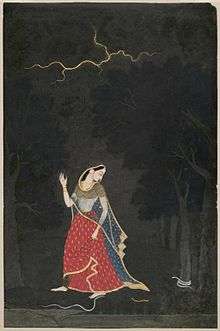Mola Ram

Mola Ram (1743–1833)[1] was an Indian painter, who originated the Garhwal branch of the Kangra school of painting.[2] He was also a poet, historian and diplomat.[3] Much research about him was done by Mukandi Lal.[4]
Life and career
He was born in Srinagar (now in Uttarakhand), and worked for the Garhwal Kingdom from 1777 until its annexation in 1803.
It is said[5] that two miniature painters of the Mughal imperial court at Delhi, Sham Das and his son Har Das (or Kehar Das[3]), accompanied Sulaiman Shikoh, the son of Dara Shikoh, when he escaped from his uncle Aurangzeb in 1658 and sought refuge from Prithvi Shah of the Garhwal kingdom, which had its capital in Srinagar. The painters remained in Srinagar as the royal tasbirdar (picture-makers), and developed the Garhwal style of miniature painting. Mola Ram was one of their descendants.[5] The inception of the Garhwal school of painting is also sometimes credited to him. His son Jwala Ram and grandson Atma Ram continued the tradition, but further descendants suspected a curse and gave up painting.[3] However, one of his descendants, Tulsi (often confused with Tulsi Mistri, another contemporary painter) was also a painter.[1]
Mola Ram himself initially painted in the Mughal style until visiting Kangra,[6] e.g. his painting Mastani is in the Mughal idiom,[7] while his later paintings, e.g. Vasakasajja Nayika,[8] are in the Garhwal style. Some of his paintings are signed.[2]
He wrote the historical work Garharajavansh ka Itihas (History of the Garhwal royal dynasty) which is the only source of information about several Garhwal rulers.[9][10] He starts with Sham Shah and goes on to describe Dula Ram Shah, Mahipati Shah, Pritam Shah, Medini Shah, Lalit Shah, and Jayakrit Shah.[11] He also wrote Ganika Natak or Garh Gita Sangram in 1800.[12] Mola Ram himself played a part in politics, helping Jayakrit Shah obtain help from Raja Jagat Prakash of Sirmaur to quell a rebellion at the battle of Karparoli.[13][14]
Notes
- 1 2 Kamboj 2003, p.119
- 1 2 Coomaraswamy 1969, pp.75–76
- 1 2 3 Kamboj 2003, p.25
- ↑ Chaitanya, p. 77
- 1 2 Hāṇḍā 2002, p.129
- ↑ Kamboj 2003, p.28
- ↑ Chaitanya, p. 80
- ↑ Chaitanya, p.32
- ↑ Hāṇḍā 2002, p.120
- ↑ Hāṇḍā & Jain 2003, p.21: "Mola Ram was witness to the collapse of dynastic rule, rise and fall of the tyrannical Gurkha hegemony through which he could steer well, and the British dominance in Garhwal. The upheavals through which the Garhwal kingdom passed during those days are most authentically recorded in his Garh Rajvansh ka Itihas. This work of Mola Ram covers the history of Garhwal from the period of Sham Shah (AD 1550-1569) to the tyrannical days under the Gurkhas and British rule."
- ↑ Hāṇḍā 2002, pp. 120–144
- ↑ Rawat 2002
- ↑ Hāṇḍā 2002, p.144
- ↑ Chaitanya, p.78
References
- Hāṇḍā, Omacanda (2002), History of Uttaranchal, Indus Publishing, ISBN 978-81-7387-134-4
- Hāṇḍā, Omacanda; Jain, Dr. Madhu (2003), Art & architecture of Uttaranchal, Bhavana Books & Prints, ISBN 978-81-86505-65-6
- Kamboj, B. P. (2003), Early wall painting of Garhwal, Indus Publishing, ISBN 978-81-7387-139-9
- Chaitanya, Krishna (1982), A History of Indian Painting: Pahari Traditions, Abhinav Publications
- Rawat, Ajay S. (2002), Garhwal Himalayas: A Study in Historical Perspective, Indus Publishing, ISBN 978-81-7387-136-8
- Coomaraswamy, Ananda K. (1969), Introduction to Indian Art (2 ed.), Munshiram Manoharlal, Delhi
External links
| Wikimedia Commons has media related to Mola Ram. |